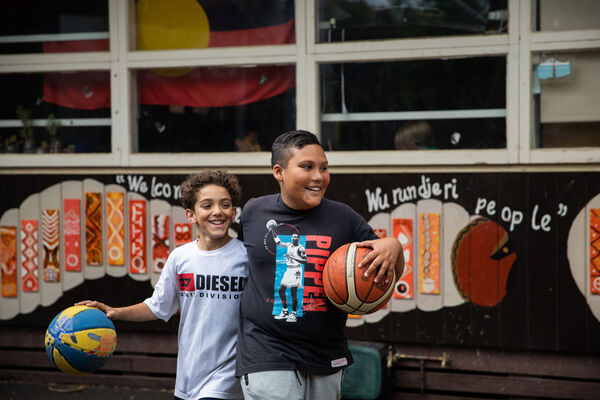Overview
Alignment with Be You Domains
-
Mentally Healthy Communities
-
Family Partnerships
-
Learning Resilience
-
Early Support
-
Responding Together
Alignment with Early Years Learning Framework (EYLF)
- Children are confident and involved learners
- Children are connected with and contribute to their world
- Children are effective communicators
- Children have a strong sense of identity
- Children have a strong sense of wellbeing
Alignment with Australian Curriculum
- Health and PE
Target audience
- Primary school
- Secondary school
Target groups
- Small group
- Whole class
- Whole school
Aims
Open Parachute aims to create generational change through equipping students with a comprehensive mental health toolkit for personal development and wellbeing, to support students to thrive within the classroom and beyond.Program theory
Open Parachute is based on self-determination theory, focusing on the importance of students building autonomy, competence and connection with their peers.
Open Parachute lessons draw on frameworks, including:
- cognitive behavioural therapy (CBT)
- dialectical behaviour therapy (DBT)
- acceptance and commitment therapy (ACT)
- mindfulness-based stress reduction (MBSR)
- narrative therapy.
These frameworks inform the teaching of psychological skills, including thought-challenging, perspective-shifting, acceptance of emotions, behaviour change and relationship skills.
Topics
Open Parachute lessons cover a range of themes that are tailored towards age and developmental stage for each year level. Topics include (but are not limited to) friendships, overcoming challenges, anxiety, inclusion, anti-bullying, resilience, change management, help-seeking, social media, and communication.Cost
Program structure
Open Parachute is designed as a curriculum that can be run from K-12, with unique grade-specific programs. There are over 500 Lessons available K-12. The primary school program contains approximately 35 unique Lessons for each year K to 6. The high school program features more than 42 unique lessons for each year level 7 to 12. Lessons are organised into topics, with around 7 topics for each year level. Each topic contains 3 to 5 sequenced lessons designed to be run weekly. Topics can be run in any order and educators can choose which topics to run. The high school programs also contain standalone lessons that can be used in any order throughout the year.Instructor
- Educator
Instructor training
Open Parachute offers a one-hour initial virtual call with the Wellbeing leaders from each school to create an implementation plan. There are another 2 options available that schools can provide to staff to assist with implementation: 1. Self-onboarding Educators can complete a self-onboarding module. 2. Group-onboarding A pre-prepared online presentation that staff can complete as a group.Supporting resources or materials available with program
- Manual
- Online webinars
- Posters
Ongoing support
Participating schools have a dedicated account manager to support them throughout the year. Live Chat is available, allowing educators to chat with a member of the Open Parachute team anytime 8am to 5pm AEST. Educators can also contact a support team via email or phone. Open Parachute also provides a 24-hour online Help Centre, which contains helpful guides and videos discussing various aspects of the program.Parent involvement
- Attend information sessions
- Attend program sessions with child
- Written information provided to parents
- Online resources
- Follow-up information provided after program
Origin of program
Australia
Open Parachute
Program authors
Dr Hayley Watson
Ratings
Summary of evidence factors
This is a summary of the evaluation or research study characteristics that contribute to the program’s evidence rating.
|
Positive impact on at least one outcome for children and/or young people?
The study reported positive outcomes. |
Yes |
|---|---|
|
Link between program description and theory of change
Theory of change refers to whether there was a comprehensive description and illustration of how and why a desired change is expected to happen in a particular context. |
Comprehensive |
|
Study design
Type of study design reported. |
Pre-post cohort |
|
Independence
The degree to which the program authors were involved in the research. |
Completely |
Summary of implementation factors
This is a summary of the program’s characteristics that contribute to its implementation rating.
|
Feedback sought from participants
Participants enjoyed the program and understood its benefits. |
Yes |
|---|---|
|
Feedback sought from instructors
Instructors enjoyed the program and understood its benefits. |
Yes |
|
Groups program is not suitable for
Groups the program wouldn't be suitable for or that required further research to determine suitability. |
Not assessed |
|
Training provided during study
The model of training provided. |
Web based |
|
Ongoing instructor support provided during study
Whether ongoing support is provided. |
Yes |
Context
This is a summary of the context in which the evidence for the program was established.
|
Study Participants
Pre school, primary school (Foundation to Year 6), secondary school (Years 7 to 12). |
Primary school Secondary school |
|---|---|
|
Country of Study/s
The location in which the evidence or research was conducted. |
Australia |
|
Location of Study/s in Australia
The state (or states) the program was assessed in Australia. |
Victoria |
|
Evaluation of program in culturally and linguistically diverse populations
Provider has included culturally and linguistically diverse people when assessing the program. |
Yes |
|
Evaluation of program in Aboriginal and Torres Strait Islander children and young people
Provider has included Aboriginal and Torres Strait Islander peoples when assessing the program. |
No |
|
Evaluation of program in low socioeconomic groups
Program has evaluated a diverse socio-economic population in their research. |
No |
|
Developmental based adaptations to program design and delivery
Shorter sessions for younger students or activities are adjusted for age appropriateness. |
No |
|
Evaluation of program in children and young people with disability and/or learning difference
Provider has included participants with a disability or learning difference when assessing the program. |
No |
Last updated: 22 November 2024
